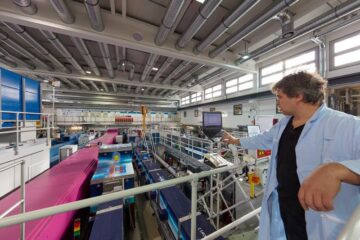Stem cells from failed clones

Xenopus embryos: valuable even when they fail. <br>© Sally Moody <br>
Frog study suggests scientists should hold onto defective clones.
Defective cloned embryos could be a source of stem cells, a preliminary study suggests1.
Cells from failed cloned frog embryos grafted into normal host embryos grow into muscle, skin and backbone, J. B. Gurdon, of the Wellcome/Cancer Research UK Institute in Cambridge, and colleagues have found.
If the same technique works for human cells it could help scientists hoping to use stem cells, which can grow into any tissue type, to treat diseases such as Alzheimer’s, Parkinson’s and heart disease. Although stem cells taken from adults look increasingly promising, some believe that stem cells from embryos are still more adaptable.
But there are huge ethical, legal and technical obstacles to therapeutic cloning – the creation of early-stage human embryos specifically to collect stem cells. Not the least of these problems is the low success rate of cloning experiments. Hundreds of eggs are wasted to produce each embryo, and only a handful of embryos survive to grow beyond a few thousand cells.
The frog finding hints that „it should be possible to use human embryos which are destined to die as a source of cells for research in order to make human cells grow and differentiate,“ Gurdon says.
„The experiment supports the argument that although cloning leads to mostly defective animals it could be used for therapeutic cloning,“ agrees Rudolf Jaenisch, who works on cloning at the Massachusetts Institute of Technology in Cambridge.
Jaenisch is hopeful that the technique will work in humans. „We are all vertebrates,“ he says. „You can assume the problems will be similar when you apply it to human cloning.“
„It is important that this debate is fostered and encouraged,“ says biomedical ethicist David Morton of the University of Birmingham, UK. But limits should be set on the use of such scientific advances, he warns.
References
- Byrne, A. J., Smonsson, S. S. & Gurdon, J. B. From intestine to muscle: Nuclear reprogramming through defective cloned embryos. Proceedings of the National Academy of Sciences, 99, 6059-6063, (2002).
Media Contact
Alle Nachrichten aus der Kategorie: Biowissenschaften Chemie
Der innovations-report bietet im Bereich der "Life Sciences" Berichte und Artikel über Anwendungen und wissenschaftliche Erkenntnisse der modernen Biologie, der Chemie und der Humanmedizin.
Unter anderem finden Sie Wissenswertes aus den Teilbereichen: Bakteriologie, Biochemie, Bionik, Bioinformatik, Biophysik, Biotechnologie, Genetik, Geobotanik, Humanbiologie, Meeresbiologie, Mikrobiologie, Molekularbiologie, Zellbiologie, Zoologie, Bioanorganische Chemie, Mikrochemie und Umweltchemie.
Neueste Beiträge

Bakterien für klimaneutrale Chemikalien der Zukunft
Forschende an der ETH Zürich haben Bakterien im Labor so herangezüchtet, dass sie Methanol effizient verwerten können. Jetzt lässt sich der Stoffwechsel dieser Bakterien anzapfen, um wertvolle Produkte herzustellen, die…

Batterien: Heute die Materialien von morgen modellieren
Welche Faktoren bestimmen, wie schnell sich eine Batterie laden lässt? Dieser und weiteren Fragen gehen Forschende am Karlsruher Institut für Technologie (KIT) mit computergestützten Simulationen nach. Mikrostrukturmodelle tragen dazu bei,…

Porosität von Sedimentgestein mit Neutronen untersucht
Forschung am FRM II zu geologischen Lagerstätten. Dauerhafte unterirdische Lagerung von CO2 Poren so klein wie Bakterien Porenmessung mit Neutronen auf den Nanometer genau Ob Sedimentgesteine fossile Kohlenwasserstoffe speichern können…





















